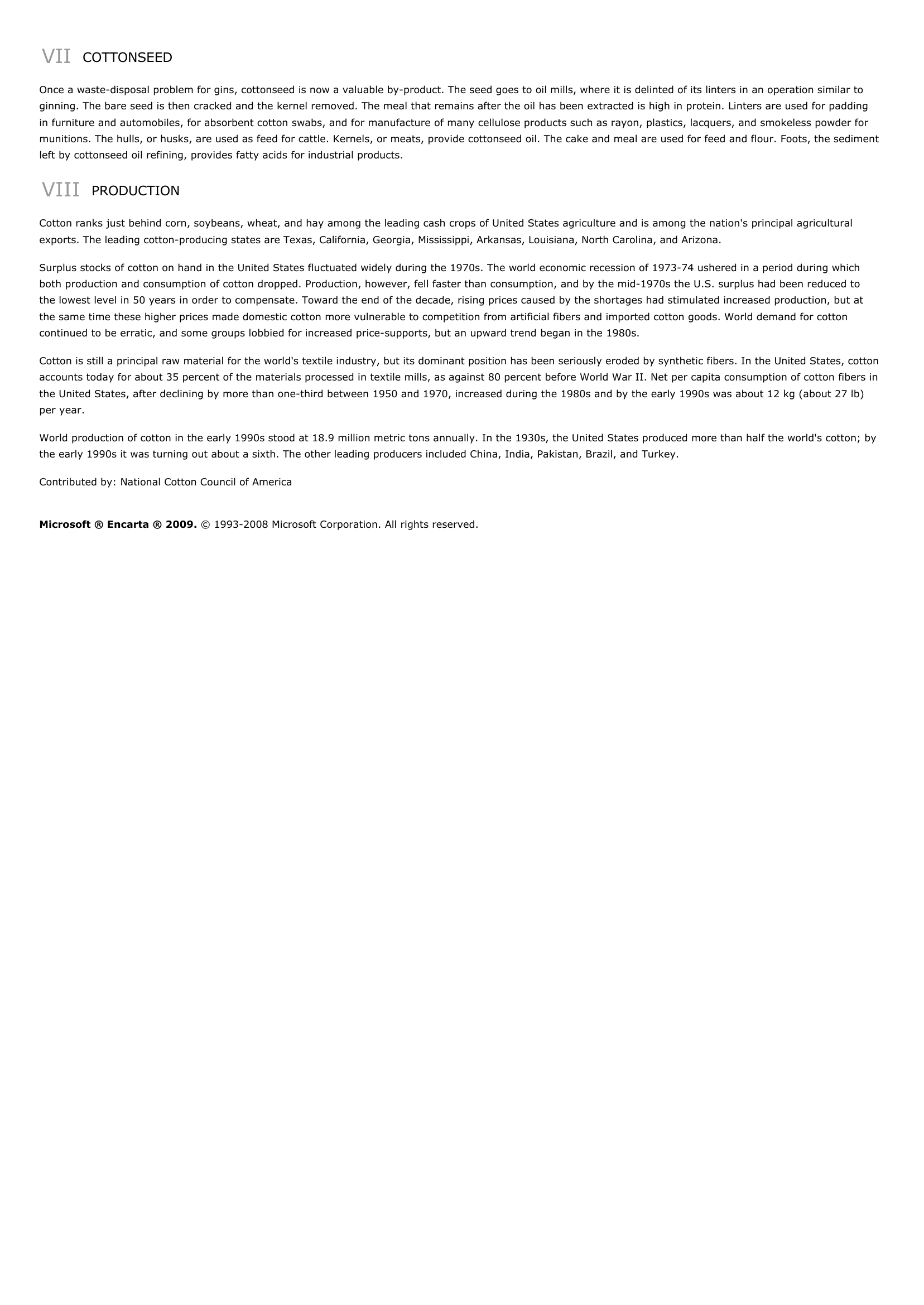Cotton - biology.
Publié le 11/05/2013

Extrait du document
«
VII COTTONSEED
Once a waste-disposal problem for gins, cottonseed is now a valuable by-product.
The seed goes to oil mills, where it is delinted of its linters in an operation similar toginning.
The bare seed is then cracked and the kernel removed.
The meal that remains after the oil has been extracted is high in protein.
Linters are used for paddingin furniture and automobiles, for absorbent cotton swabs, and for manufacture of many cellulose products such as rayon, plastics, lacquers, and smokeless powder formunitions.
The hulls, or husks, are used as feed for cattle.
Kernels, or meats, provide cottonseed oil.
The cake and meal are used for feed and flour.
Foots, the sedimentleft by cottonseed oil refining, provides fatty acids for industrial products.
VIII PRODUCTION
Cotton ranks just behind corn, soybeans, wheat, and hay among the leading cash crops of United States agriculture and is among the nation's principal agriculturalexports.
The leading cotton-producing states are Texas, California, Georgia, Mississippi, Arkansas, Louisiana, North Carolina, and Arizona.
Surplus stocks of cotton on hand in the United States fluctuated widely during the 1970s.
The world economic recession of 1973-74 ushered in a period during whichboth production and consumption of cotton dropped.
Production, however, fell faster than consumption, and by the mid-1970s the U.S.
surplus had been reduced tothe lowest level in 50 years in order to compensate.
Toward the end of the decade, rising prices caused by the shortages had stimulated increased production, but atthe same time these higher prices made domestic cotton more vulnerable to competition from artificial fibers and imported cotton goods.
World demand for cottoncontinued to be erratic, and some groups lobbied for increased price-supports, but an upward trend began in the 1980s.
Cotton is still a principal raw material for the world's textile industry, but its dominant position has been seriously eroded by synthetic fibers.
In the United States, cottonaccounts today for about 35 percent of the materials processed in textile mills, as against 80 percent before World War II.
Net per capita consumption of cotton fibers inthe United States, after declining by more than one-third between 1950 and 1970, increased during the 1980s and by the early 1990s was about 12 kg (about 27 lb)per year.
World production of cotton in the early 1990s stood at 18.9 million metric tons annually.
In the 1930s, the United States produced more than half the world's cotton; bythe early 1990s it was turning out about a sixth.
The other leading producers included China, India, Pakistan, Brazil, and Turkey.
Contributed by: National Cotton Council of America
Microsoft ® Encarta ® 2009. © 1993-2008 Microsoft Corporation.
All rights reserved..
»
↓↓↓ APERÇU DU DOCUMENT ↓↓↓
Liens utiles
- MERVEILLES DU MONDE INVISIBLE (Les) de Cotton Mather - résumé, analyse
- Cotton Aimé Auguste, 1869-1951, né à Bourg-en-Bresse (Ain), physicien français.
- Alligator - biology.
- Amphibian (animal) - biology.
- Basilisk - biology.


